




When higher education institutions create mentorship programs, students and faculty can see an increase in engagement, retention, and productivity. Mentors can encourage students and guide them to success, but you must have a program outline and communicate your expectations and ideas with your team.
Mentorships enrich both the mentor and the mentee, and students can make valuable connections, discover new opportunities, and seek expert knowledge and skills for their careers. This guide will teach you how to mentor students at your institution by creating an effective program that meets everyone’s needs.
Advisors and mentors may seem similar, but they have very different roles. Although both have professional experience, advisors and mentors use it differently to guide others. Advisors have a formal function and give others a sense of direction. Mentors perform a similar role but use personal experience, knowledge, and skills to lead others to success. Mentors can act as role models and develop deep connections with mentees, while advisors have a more surface-level relationship.
Many people can be advisors, while only some can serve as mentors. An advisor directs others to perform tasks, but a mentor guides mentees through career and personal development. Mentors consider personal obligations, passions, and goals and encourage mentees to seek their own paths. On the other hand, advisors do not take a social-emotional approach but expect others to complete objectives despite them.
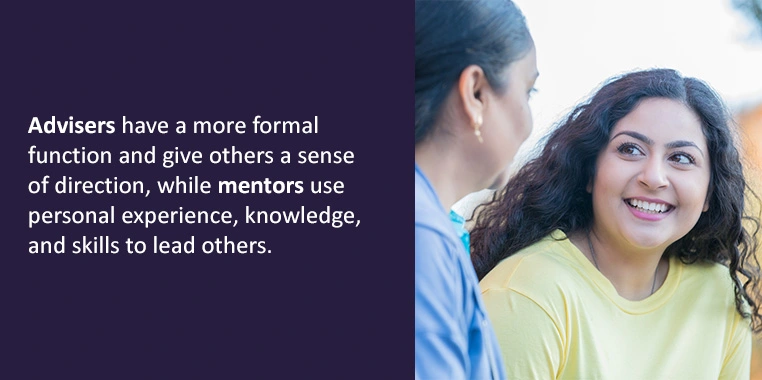
Students may have an advisor who tells them which classes they should take, when to begin an internship, or which clubs would be most beneficial for their resume. In a sense, the advisor encourages the student to check off the boxes that will enable them to graduate on time. A mentor is more inclined to know the mentee personally. Mentors will understand the student’s motivation and suggest courses, clubs, internships, and other valuable resources that align with the student’s interest.
Mentors can take different roles and structure the relationship in various ways. Although many believe mentors must be old and wise, mentors can also be young, bright minds or peer mentors. Some mentors provide emotional support, teaching coping methods and stress-relieving practices, while others share industry knowledge and expertise. Still, other mentors act as an all-encompassing helping hand who guides mentees to success in one form or another.
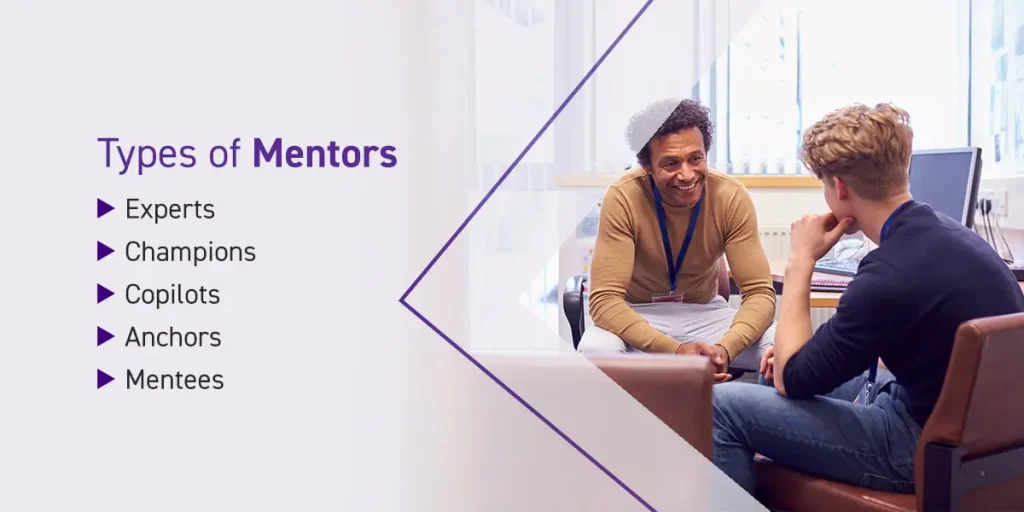
Types of mentors include:
A mentor relationship may take many forms, but no matter the structure, those in mentorship roles must maintain specific responsibilities. These responsibilities guide the mentorship process and ensure mentees get the most value from the relationship. Current or prospective mentors who understand their responsibilities can use this knowledge to improve their mentorship.
A mentoring relationship functions best when both sides work together to set goals. Depending on the nature of the relationship and the particular mentee, these objectives may change. Establish goals early in the mentorship to set the path to follow as the relationship continues. These goals can include general development, career-focused objectives, or emotional support.
Though many goals focus on advancing the mentee, mentors may also set goals for their own development, like growing their leadership or communication skills. The mentor should share these goals with the mentee so the mentee can provide feedback that helps the mentor improve their skills.
Once the mentor and mentee have set goals, the mentee will often come with questions. Mentors answer these questions, drawing on their own experiences and successes to provide valuable feedback that the mentee can use as they work toward their goals. Mentors must consider each question thoughtfully and spend time formulating responses. They can refer to their story or information gained through experience to give actionable advice.
Mentees rely on a mentor to guide their success in a particular field. The relationship works best when both individuals play an active role. The mentee may come with questions, but mentors should also reach out to offer support. The particular support provided will vary based on the relationship and the mentee. A mentor has experienced similar struggles in their journey. They can use this experience to listen to the student and provide encouragement.
College or university student mentoring can be incredibly beneficial for students and staff when everyone practices the proper methods. Additionally, mentoring college students can benefit your instructors and faculty, but you should establish a program that works for everyone. Encourage your team to collaborate and determine the best schedule, policies, procedures, and student mentoring report format.
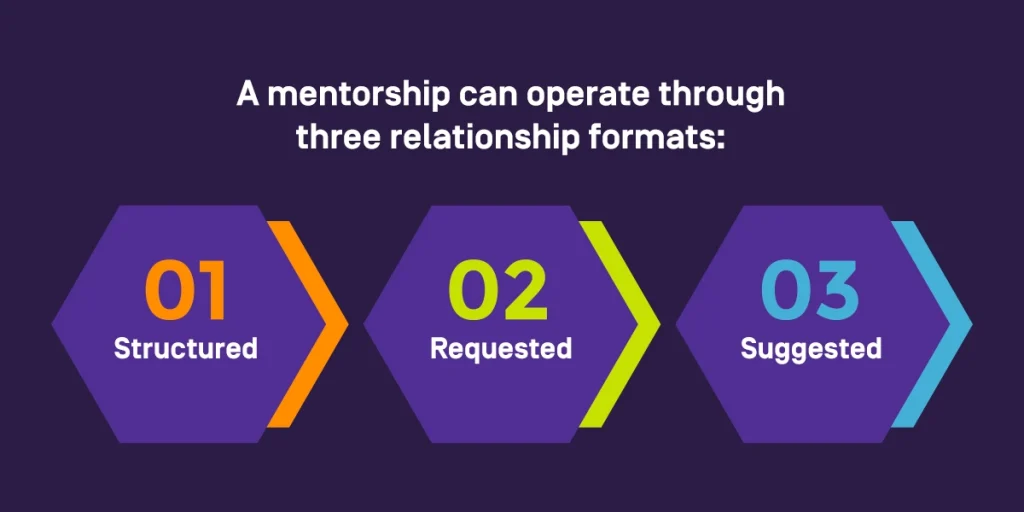
A mentorship is only as strong as the relationship between mentor and mentee. At the beginning of the mentorship, you should establish goals and expectations so both parties understand their role. Mentors must also take the first step to develop the relationship with their mentees to create a trusting rapport.
A mentorship can operate through three relationship formats:
Any professional relationship requires boundaries, especially in higher education institutions. First and foremost, the mentor and mentee should always feel respect from the other. Mentorship is a deep connection — neither party should feel that one is more important than the other.
The mentor and mentee should create a schedule together and determine their preferred methods of communication and when it is appropriate to reach out. A mentorship doesn’t always mean unlimited access — face-to-face communication at set intervals sometimes works better than consistent online or phone communication.
Before engaging in this professional relationship, the mentor and mentee should also discuss confidentiality. The mentor relationship often involves both parties sharing personal information with someone they trust. The mentor and mentee should discuss privacy and how the concept applies to various scenarios in their professional relationship.
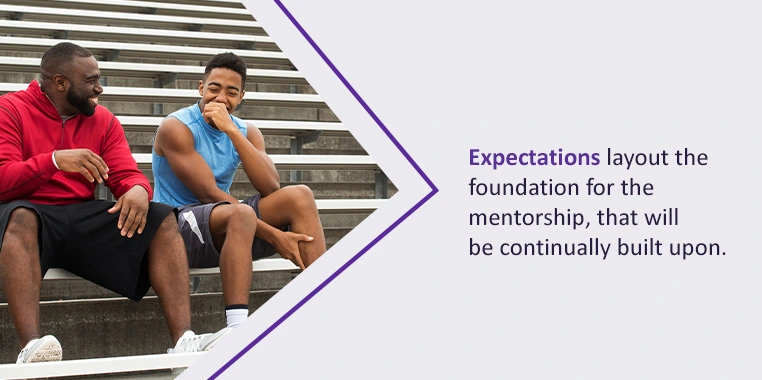
When mentors and mentees express expectations in the beginning, both people can move forward knowing what the other expects. Expectations will lay the foundation for the mentorship, and the mentor and mentees will craft a relationship around this foundation. These solid frameworks will also show the mentee what role their mentor is playing. They will know whether it’s appropriate to ask their mentor for emotional or mental support or if they should rely on them to discover exciting courses of study.
Generally, mentees expect their mentors to be available at set intervals and provide trustworthy advice. Mentors anticipate that mentees will take their advice seriously and take responsibility for the relationship, as the mentee’s goals drive the progression. Mentors or mentees who expect more or less from the relationship should discuss these ideas with a mentor to ensure both parties know what to expect.
A mentorship is nurturing and continues to grow as the relationship continues. However, a mentorship should be a reliable connection rather than a constant obligation. Although many mentorships become lifelong friendships, others can be more formal, and mentor and mentee must exhibit the same amount of effort. Although mentors want to help students grow, they must ensure they understand their learning experience and not overwhelm them or provide uninteresting opportunities.
Mentors and students should practice self-care and understand when to give themselves a break. When people overextend themselves, they become burnt out and less helpful to others. Additionally, if students feel their mentorship is a chore, they may avoid contacting their mentor or neglect their other work.
Mentorship programs help institutions encourage, engage, and motivate students to complete their studies and achieve their goals. With a reliable mentor, students can forge new connections, improve their mental well-being, engage more deeply with their studies, and enhance their campus experience.
These tips for mentoring students will help you build a strong program that pushes your students to success.
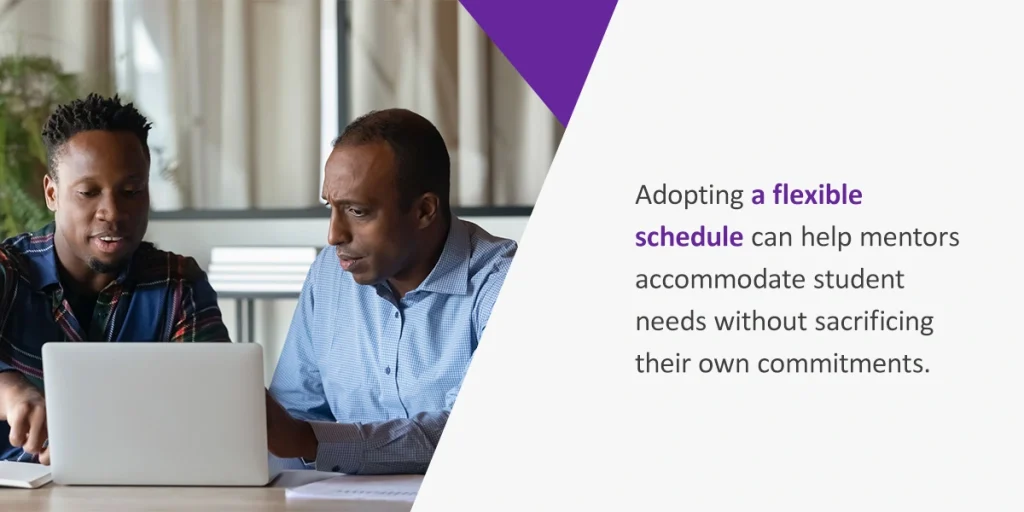
Balancing work, family, extracurricular activities, and coursework makes student life challenging. Although regular meetings are important for reporting progress and building rapport, mentors need to remember that their students may need to quickly change plans to get everything done.
Adopting a flexible schedule can help mentors accommodate student needs without sacrificing their own commitments. Many calendar and scheduling tools show when one or both parties have other appointments, making it easy to coordinate new meeting dates when life gets hectic. Plus, mentors can use video conferencing tools like Zoom to hold virtual meetings if a student knows they can’t meet in person.
Mentorships work best when both parties are on the same page, which is why frequent and transparent communication is so vital. Some key areas mentors should focus on include:
It’s also important to remember that communication is a two-way street — mentors need to encourage students to ask questions and advocate for themselves anytime they need assistance or clarification.
Your institution collects a lot of data about student performance. Measuring student progress over time using this data can help mentors make sure their students are on the right track. It can also enable them to catch minor issues before they escalate into major problems. For example, if a mentor sees their student’s grades are slipping, they can refer that student to the appropriate campus resources to re-engage them.
Additionally, students should regularly attend meetings and report honestly on their progress. A check-in system that provides automated updates can help mentors hold their students accountable for attending appointments and classes.
A strong bond of trust and understanding is critical for a successful mentorship. A mentor matching system can help you pair each student with their ideal mentor.

When students sign up to participate in the program, ask them to fill out a survey with information such as:
Mentors should also be doing their part to build rapport. In their first meeting, mentors should discuss the student’s motivations and interests to gain insight into how they can best help the student moving forward.
After a higher education institution develops a mentoring program, the next step is to determine the program’s success to guide future improvements. Mentorship brings several advantages for students, mentors, and educational institutions. Schools use such programs to accomplish goals like student retention. Students benefit from mentoring by achieving academic or career success, and mentors gain practical skills like leadership.
These benefits only happen when institutions have straightforward ways to measure success, like:
Implementing robust data analytics software can help you consolidate all your program data for easy analysis and reporting. This technology can help you quickly generate the insights you need to adjust your program and achieve better results.
At Watermark, we understand the importance of mentorships and want to help you craft a program that works for your faculty and students. We encourage higher ed institutions to utilize success coaches to create holistic educational experiences and guide students to their goals. We can help you design a program that benefits your students and improves your institution.
Browse our case studies to see how we’ve helped other higher education institutions engage students, or contact us to learn more about what we can do for you.





























































































































































































































































































































































































